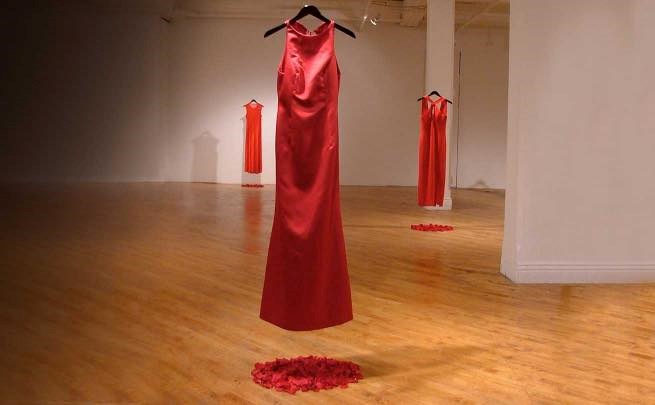MOOSE JAW — Red dresses hung in windows, libraries, and community spaces across Moose Jaw as residents marked Red Dress Day — a national day of remembrance for Missing and Murdered Indigenous Women, Girls, and Two-Spirit People (MMIWG2S+).
Observed annually in May, the day encourages reflection, awareness, and action on the ongoing crisis disproportionately affecting Indigenous communities. In Moose Jaw, individuals, local organizations, and city officials joined voices to honour lives lost and demand justice.
“Today, the City of Moose Jaw honours and remembers the missing and murdered Indigenous women, girls, and two-spirit people,” read a statement posted by the city. “Join us in wearing red to raise awareness and stand in solidarity with Indigenous communities. Get involved and advocate for justice to create a safer future for all.”
Red dresses — inspired by Métis artist Jaime Black’s REDress Project — served as a visual and symbolic tribute. The installations across Canada aim to represent the absence of those who are missing and murdered, and the hope that justice may one day be found.
At the Moose Jaw Public Library, staff marked the day by sharing resources to help educate the public about the significance of Red Dress Day. The library promoted readings and online materials to inform residents about the National Inquiry into MMIWG and Canada’s colonial legacy.
The Moose Jaw Transition House echoed the day’s message on its social media platforms.
“Red Dress Day serves as a reminder to raise awareness about the lives lost and the urgency of creating change,” the post read. “Let’s continue to raise our voices, support survivors, and ensure that no one is left behind in the fight against violence.”
For many local residents, the day is deeply personal.
“Today is MMIWG day, one day of the year that many will acknowledge,” wrote Moose Jaw resident Jody Oakes, “but as a mom to Indigenous daughters, it’s something I think of each day.”
Oakes paid tribute to families still searching for their loved ones, including those of Happy Charles and Ashley Morin, whose disappearances remain unsolved.
“Our beautiful daughters are more than statistics, they are loved, they matter,” Oakes added. “We leave our red dress hanging in our window all year with a candle we hope some beautiful spirit can see.”
Oakes also shared lyrics from Mitch Daigneault’s song, a personal anthem of grief and resilience: “Leave a red dress in the window, and a candle I can see.”
Across Saskatchewan, the provincial government reaffirmed its support for grassroots initiatives through the Missing and Murdered Indigenous Women and Girls+ Community Response Fund, which helps fund safety initiatives and public awareness campaigns.
The Canadian Institutes of Health Research (CIHR) notes that over 60 per cent of Indigenous women in Canada have experienced physical or sexual assault in their lifetime — a legacy of violence that continues to impact health, safety, and well-being.
Red Dress Day aligns with the Truth and Reconciliation Commission’s Calls to Action and the National Inquiry’s Calls for Justice, which urge Canadians and governments to address the systemic factors contributing to MMIWG2S+.
“On Red Dress Day, and every day, we honour the lives and legacies of MMIWG2S by listening to their stories and commemorating their strength and spirits,” the CIHR said in a statement. “We stand in solidarity with the families and communities who continue in the pursuit of justice, healing, and change.”
Resources for those impacted by the MMIWG2S+ crisis include the Hope for Wellness Help Line at 1-855-242-3310 and the National Family and Survivors Circle at 1-844-413-6649, which offer 24/7 support.




